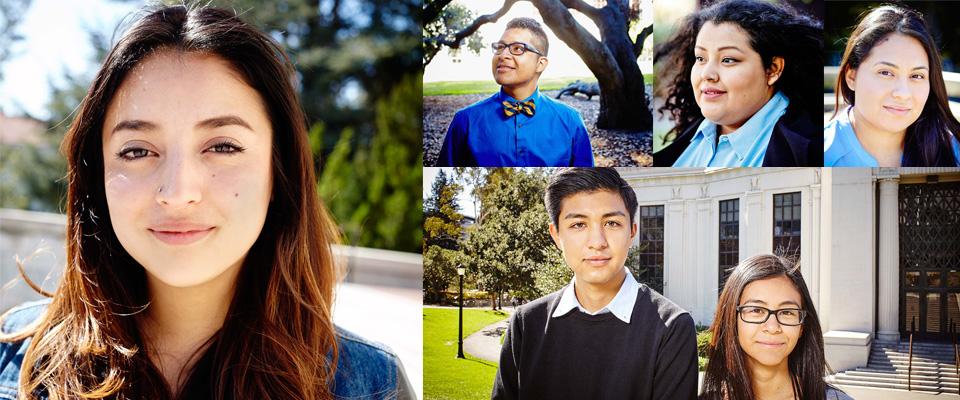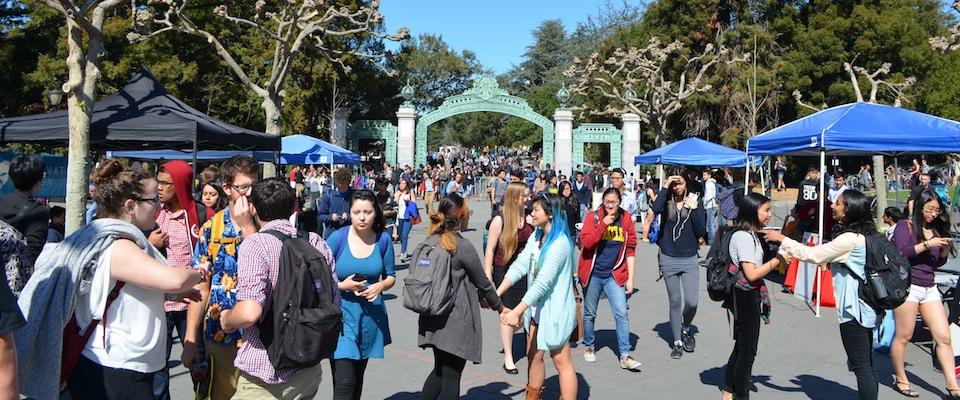Currently, 17 percent of Berkeley undergrads are first-generation—a group that struggles to cope with the transition to college.
When Gabriela Ledezma was accepted at UC Berkeley as a transfer student from Rio Hondo Community College in Whittier a few years ago, she was delighted. Her family, not so much.
“My mom said, why don’t you just go to Cal State LA—it’s just down the street,” she recalls. But Ledezma knew what she wanted to do and is now a senior at Berkeley, with a double major in psychology and legal studies.
Ledezma, 23, was born in Mexico and came to California with her family when she was 3; she currently has a student visa. She always knew that her parents put a high priority on education, even though neither had attended college. Her father, a construction worker, didn’t go to school after the sixth grade. Her mother managed to get her GED in the United States. Two older sisters briefly attended community college, but married at 20 and didn’t finish. That wasn’t the route Ledezma wanted to take.
She was encouraged and discouraged by her family at the same time. Her parents liked that she was diligent, but didn’t see why she needed to be involved in Rio Hondo’s student government or to participate in sports and clubs. “My father’s understanding was that at 18 years old, you go to school, you go to work to help with the rent, you come home and you help with dinner,” she says. “His mentality was short-term, because it had to be. I was thinking long-term.”
Ledezma’s experience is not unusual for first-generation students—those students whose parents didn’t attend college. Many receive these kinds of mixed messages from home and friends. Parents express both pride that their child will excel and fear that they’ll evolve into someone the family no longer recognize.
The students themselves often feel that they just don’t understand what other college students seem to grasp intuitively. Such pressures, often combined with language barriers, poverty, and loneliness, mean these students are at greater risk of dropping out.
“If you’re a first-generation student, you’re more likely to feel like you can’t fit in—and more likely to leave,” says Amy Baldwin, who has worked with first-generation students in numerous capacities, most recently as chair for college studies at Pulaski Technical College in Arkansas. She also authored a book, The First-Generation College Experience.
Even though there has been a great deal of emphasis on encouraging first-generation students to pursue higher education, there has been less emphasis, until recently, on making sure they complete their studies once they have matriculated.
Not all first-generation students are low income, but there is substantial overlap in the demographics. At Berkeley, just under 60 percent of first-generation students qualify as low-income, says Fabrizio Mejia, executive director for Berkeley’s Centers for Educational Equity and Excellence, which assists first-generation students, veterans, undocumented students, and others in finding their way at the University.
Nationally, some 4.5 million low-income, first-generation students are enrolled in post-secondary education—about 24 percent of the undergraduate population—but only 11 percent earn a bachelor’s degree after six years, according to a 2008 Pell Institute study (the most comprehensive available on first-generation students). The study also found that nearly 60 percent of first-generation students who drop out do so in their first year.
“A campus really needs to understand the challenges of first-generation. It’s like going to a different country.”
The national dropout rate for all college students is astonishingly high. Less than two-thirds (59.4 percent) of full-time students who entered a four-year college for the first time in 2007 graduated within six years. Just under 40 percent complete in four years.
Of course, wide variations exist. Generally speaking, the more selective the college, the higher the graduation rate. Schools that are open to virtually all students have a graduation rate of 34.1 percent; those with an acceptance rate of less than 25 percent report a graduation rate of 88.9 percent.
This holds true at Berkeley, where 88 percent of students entering as freshmen in 2008–09 graduated within five years, according to the University’s Office of Planning and Analysis. But the graduation rate was 79 percent for first-generation students, who made up close to one-fifth of that year’s incoming class. Of transfer students (almost one-third of the total number of new students at Berkeley, usually at the start of junior year and typically from a community college) in 2010–11, 83 percent graduated within three years of transferring. That’s just a few percentage points below non–first-generation students.
Students at more selective universities often arrive better prepared and they often have access to more resources aimed at helping them stay in college, compared to those who enter less selective colleges, experts say. If counselors and advisors aren’t closely monitoring such students, they can easily fall through the cracks because of the most basic misunderstandings. “I had one student who was a freshman in the fall and didn’t realize he had to re-register for the spring,” Baldwin says. “He said he thought it would happen automatically.
“A campus really needs to understand the challenges of first-generation. It’s like going to a different country,” she adds. “Faculty and staff have to be informed of the need to be both more explicit and more sensitive. I explain everything. For example, I might say, ‘Go talk to your professor,’ and the student doesn’t know what to say when he gets there. So I have to break it down, and almost write a script.”
Officials in higher education have grappled for years with developing effective strategies to ensure that low-income and minority students get their degrees, but it is only relatively recently that first-generation students have been viewed as a population with separate needs. That’s for a number of reasons, one being a growing realization that the overarching labels of “low income” and “minority” don’t take into account the differences within those groups.
“We’re moving away from the traditional ways of defining diversity on race and economic grounds,” says Matt Rubinoff, executive director of the Center for Student Opportunity, a national nonprofit that created the I’m First initiative to provide information and resources for first-generation students.
It doesn’t hurt that one of the residents of the White House was a first-generation college student. Last year, First Lady Michelle Obama released a video that deftly shows what experts say is the key challenge facing first-generations students: a lack of what’s called “academic” or “educational capital”—or “the hidden curriculum.” These students may not know about basic services and policies taken for granted by those who grow up in families where college is the norm: pre-college orientation, professors’ office hours, dining plans, spring break trips. Michelle Obama shares in the video that “I didn’t know how to choose my classes or find the right classrooms. I didn’t even know how to furnish my own dorm room. In fact, when I moved in, I realized that I hadn’t even packed the right size sheets for my bed. Mine were way too short. So that first night, I slept with my legs sticking out past the end of the sheets, rubbing up against one of those old plastic mattresses … and I ended up sleeping that way for my entire freshman year.”
Parents say, “It’s wonderful you got into college, but we really miss you at home.” Old neighborhood friends who stay close to home may view you as stuck-up. The programs that enrich the college experience—such as study abroad, working for a professor, or playing intramural sports—may seem to be a waste of time.
It’s not just understanding the logistics, it’s feeling comfortable enough to engage in all parts of college life. Research shows that involvement in activities outside of class and connection with peers and professors all greatly improve a student’s chances at staying in school. But first-generation students, even more than poor and low-income students, have “significantly lower levels of social involvement, lower levels of academic involvement, even after taking into account background differences,” says Gary Pike, a professor of higher education and student affairs at Indiana University.
Echoing Ledezma’s experiences, Pike refers to the double bind many such students find themselves in. Parents say, “It’s wonderful you got into college, but we really miss you at home.” Old neighborhood friends who stay close to home may view you as stuck-up. The programs that enrich the college experience, such as study abroad, working for a professor, or playing intramural sports, may seem to be a waste of time, Pike says. Particularly difficult for these students, experts say, is choosing to go to a school far from home, where they live on campus.
David Beard, associate professor of rhetoric, scientific, and technical communication at the University of Minnesota, Duluth, was the sixth person in his family to get through middle school, the fourth to finish high school, and first to go to college and then graduate school. “When I was accepted into a doctoral program, my grandfather said, ‘Isn’t it time to quit all this school foolishness?’”
Today Beard mentors students like himself and sees the challenges they face, such as not realizing they can write in a college textbook they have purchased, or a student whose husband was so uncomfortable with her being in college that she did her homework in the car.
John Douglass, a senior research fellow in public policy and higher education at Berkeley, warns against lumping all first-generation students together, noting that there may be large cultural differences between, say, a typical immigrant family from rural Guatemala and one from a city in Vietnam.
“Certain groups know better how to take advantage of government programs, have more sophistication and worldliness even without a degree,” he notes. Nonetheless, he says, having at least one parent who went to college is the “best indicator of whether you’re going to go to college and get a degree.”
Mejia, of Berkeley’s Centers for Educational Equity and Excellence, grew up in Sacramento and was a first-generation student when he entered Cal as a freshman. He recalls the “push/pull” he felt at home. “My mom was always clear I was going to college, but always wanted me to stay home,” he says. When a relative wondered why he needed to go so far away to Berkeley when there was a college around the corner, Mejia says, “I didn’t have the language to explain. If my parents had gone to college, they would have understood the hierarchy and prestige of different universities.”
As attention on first-generation students has grown, so have programs to help them. Cal gets in touch with such students even before they even enroll, says Mejia. “We want to be sure that they will come,” he explains, and not opt for a lesser college closer to home or be lured by the Ivies. Once enrolled, there’s an option for freshmen and transfer students to take a one- or two-credit class that introduces students to the resources Berkeley offers. The Center also offers one-on-one counseling, and provides ongoing information to students through social media.
Berkeley isn’t the only university putting programs in place to help first-generation students. Other efforts include the University of North Carolina at Chapel Hill’s program, Carolina Firsts (18.6 percent of UNC’s incoming freshmen are first generation); and Loyola Marymount’s First To Go program. And for those who want to continue on to postgraduate work, there’s the federal McNair Scholars Program, specifically designed to provide financial assistance to first-generation students and other underrepresented groups who want to pursue advanced degrees.
For Ledezma, now a senior, the road has been “amazing” but hard. Besides double-majoring, she holds down three part-time jobs: at the university’s office for transfer students, at a café off campus, and taking class notes for disabled students.
Although such ongoing support programs are needed, even seemingly small initiatives can make big differences. Nicole Stephens, an associate professor at Northwestern’s Kellogg School of Management, found that a one-hour intervention focused on discussions of social class can significantly narrow the achievement gap between first-generation college students and those who have at least one parent in college.
Along with coauthors MarYam Hamedani, associate director of the Center for Comparative Studies in Race and Ethnicity at Stanford, and Mesmin Destin, assistant professor of psychology at Northwestern, Stephens conducted an experiment at the beginning of the academic year. In one intervention, third- and fourth-year students with widely varying backgrounds talked to a group of incoming freshmen—some first generation, some not. They discussed personal stories as well as obstacles and strategies for college success that they linked to their different social class backgrounds.
In another intervention, older students discussed the same issues without reference to social class. The results: Those who heard the older students talk about social class did better in every area, from academics to social involvement, than those who hadn’t.
“Talking about social class gives first-generation students a framework to understand how their own backgrounds matter in college, what unique obstacles they may face, and [to] see that people like them can be successful,” the researchers wrote.
Beard, of the University of Minnesota, who has experienced the difference of besing a first-generation student as well as a first-generation professor, said he strongly feels the need to mentor first-generation students who, like him, often feel lost and out of place. “I’m not so much a role model,” he says, “as a validation of who they are.”
For Ledezma, now a senior, the road has been “amazing” but hard. Besides double-majoring, she holds down three part-time jobs: at the university’s office for transfer students, at a café off campus, and taking class notes for disabled students.
“My housemates all say, ‘Gabby, you work too hard, take a break,’ but I can’t. Sometimes I’m frustrated; sometimes I wish I could take it easy.” But mostly, she is proud of how far she has come. She is now debating whether to go to law school or get a Ph.D. in forensic psychology.
“As a first-generation student, I was learning what higher education was all about at the same time my parents were learning,” she says. She hopes her younger brother, now in high school, will have it a little easier. “I tell him, ‘If I did it, you have no excuse not to go to college.’ I’m giving him no option.”
Alina Tugend writes the “Short Cuts” column for The New York Times. She has Berkeley degrees in history and journalism. Follow her on Twitter at @tugend and see more of her work at www.alinatugend.com.




















